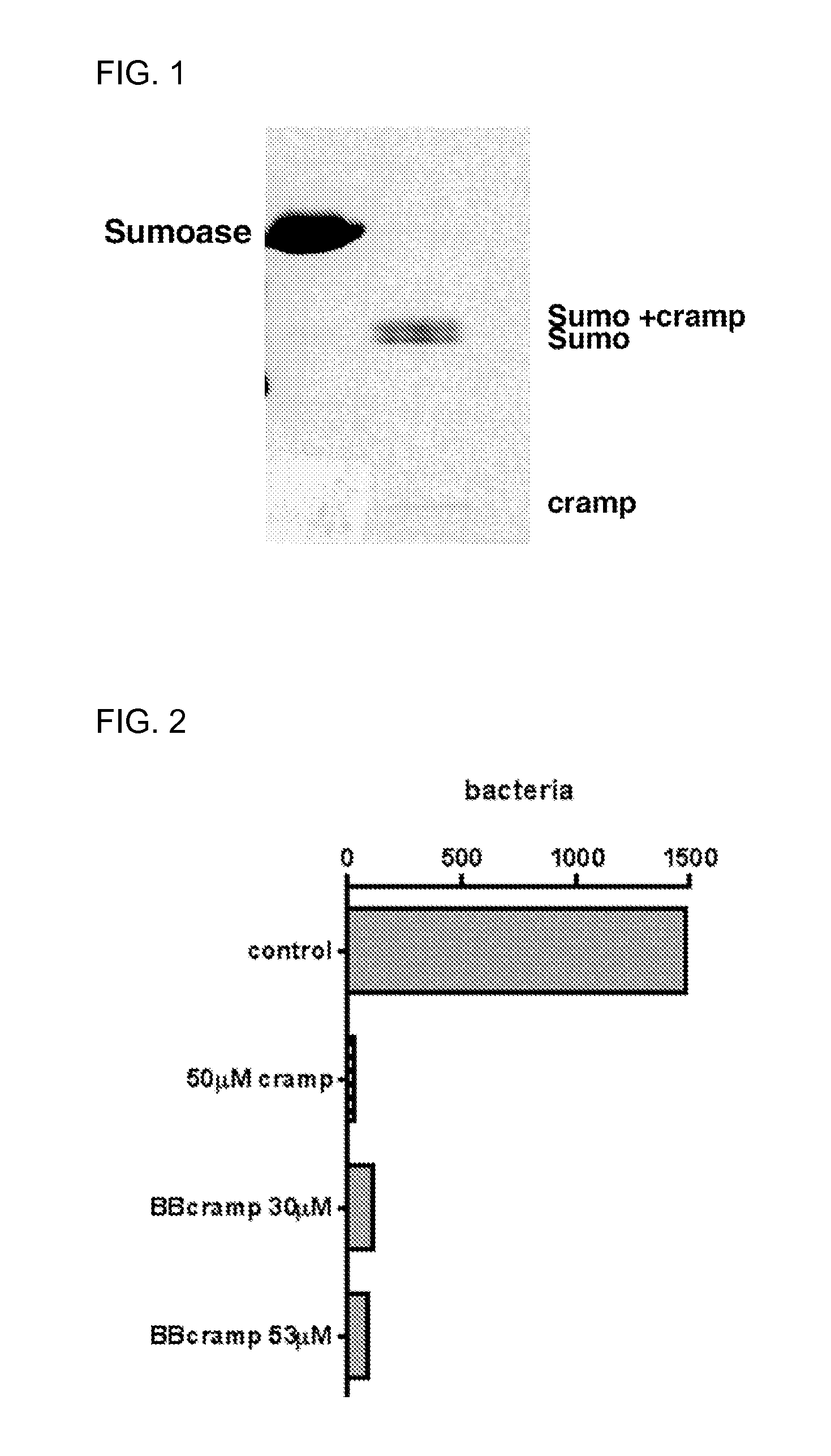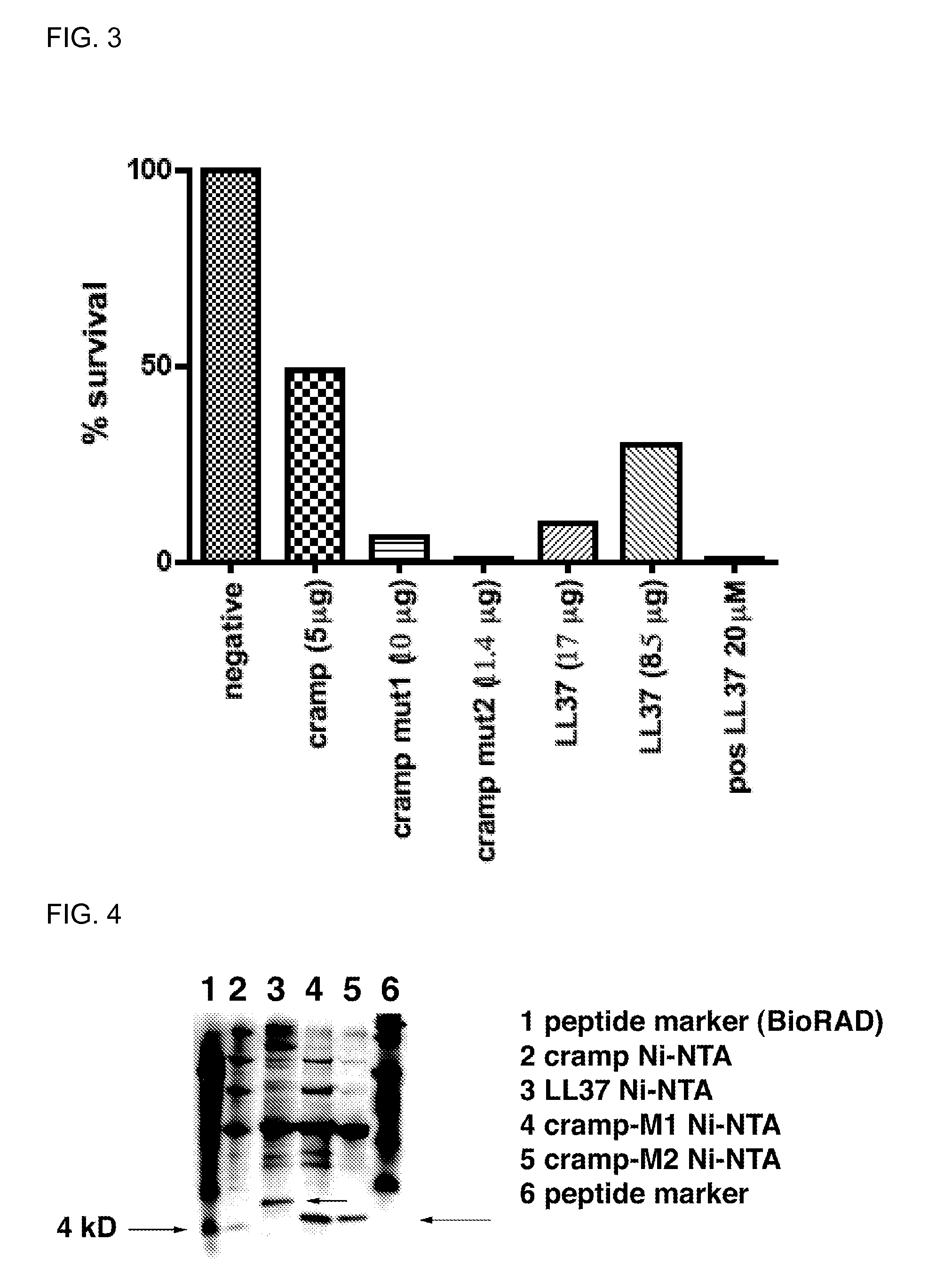Production of Anti-microbial peptides
a technology of antimicrobial peptides and peptides, which is applied in the field of producing antimicrobial peptides, can solve the problems of difficult recombinant expression of these peptides in bacterial cells, high cost of synthesizing these peptides, etc., and achieves the effects of reducing the native antimicrobial activity of the amp, reducing or inhibiting the ability of the amp to kill, and increasing the stability of the fusion protein
- Summary
- Abstract
- Description
- Claims
- Application Information
AI Technical Summary
Benefits of technology
Problems solved by technology
Method used
Image
Examples
example 1
Generation of SUMO-AMP Fusion Proteins
[0178]This example describes methods used to generate a fusion protein that includes SUMO fused to the N-terminus of CRAMP (wild-type or mutated) or the N-terminus of LL37. However, one skilled in the art will appreciate that similar methods can be used to generate similar fusion proteins for any AMP of interest, such as a defensin, by substituting the CRAMP or LL37 sequence with the other AMP sequence. Similarly, these methods can be used to operably link the SUMO to the C-terminus of the AMP.
SUMO-CRAMP
[0179]The full-length CRAMP (mouse specific cathelicidin-related antimicrobial peptide) RNA was isolated from tissue-cultured mouse mast cells using the Qiagen RNA purification protocol. CRAMP cDNA was created using the RT-kit from Ambion. The cDNA was used in a PCR reaction using the primers below to amplify the full-length gene of CRAMP and to insert a FLAG purification tag on the C-terminus of the CRAMP gcgcgggcatatgGGACTTCTCCGCAAAGGTGG (SEQ I...
example 2
Protein Purification
[0194]This example describes methods used to purify the SUMO-AMP fusion proteins generated in Example 1 (e.g., SEQ ID NOS: 40, 45, 47, 49, and 51), and digest them with sumoase to release functional AMP (e.g., SEQ ID NOS: 53, 46, 48, 50, and 52, respectively). One skilled in the art will appreciate that similar methods can be used to purify similar fusion proteins for any AMP of interest, such as a defensin.
[0195]Protein pellets were dissolved in 1 / 50 of the original volume of lysis buffer (50 mM NaH2PO4 pH 8.0+300 mM NaCl+10 mM Imidazole) and sonicated at position 3 (Fisher ultrasonicator) for either 3×30 sec (trial volume) constant or 8×30 sec constant with ice cooling. The resulting lysis solution was centrifuged at 13000 rpm for 10 minutes, the clear supernatant was considered crude extract containing sumo-cramp and added to either 1 ml (trial run) of Ni—NTA equilibrated in lysis buffer or 2.5 ml of Ni—NTA equilibrated in lysis buffer.
[0196]The slurry was rot...
example 3
Functionality Assay
[0200]This example describes methods used to demonstrate that the resulting CRAMP and LL37 peptides (e.g., SEQ ID NOS: 46, 48, 50, 52 and 53) generated in Example 2 had antimicrobial activity. One skilled in the art will appreciate that similar methods can be used to confirm the functionality of any AMP of interest, such as a defensin.
[0201]The OD600 of a Citrobacter rodentium overnight culture was measured and a dilution series was performed. 100 μl of a 7.1×102 bacteria / ml dilution was used in the functionality assay. For CRAMP, the control culture had an additional lysis buffer+sumoase added, the CRAMP positive control had 50 μM CRAMP (Sigma Genosys) added and CRAMP peptide obtained in Example 2 was added at 30 μM or 53 μM (FIG. 2). For LL37, the positive control had 20 μM pure synthetic LL37 (Microchem Facility, Emory) added, and LL37 peptide obtained in Example 2 was added at 8.5 μg (250 μl) or 17 μg (500 μl) (FIG. 3). 20 μM concentration of the synthetic pep...
PUM
| Property | Measurement | Unit |
|---|---|---|
| pH | aaaaa | aaaaa |
| nucleic acid | aaaaa | aaaaa |
| stability | aaaaa | aaaaa |
Abstract
Description
Claims
Application Information
 Login to View More
Login to View More - R&D
- Intellectual Property
- Life Sciences
- Materials
- Tech Scout
- Unparalleled Data Quality
- Higher Quality Content
- 60% Fewer Hallucinations
Browse by: Latest US Patents, China's latest patents, Technical Efficacy Thesaurus, Application Domain, Technology Topic, Popular Technical Reports.
© 2025 PatSnap. All rights reserved.Legal|Privacy policy|Modern Slavery Act Transparency Statement|Sitemap|About US| Contact US: help@patsnap.com



